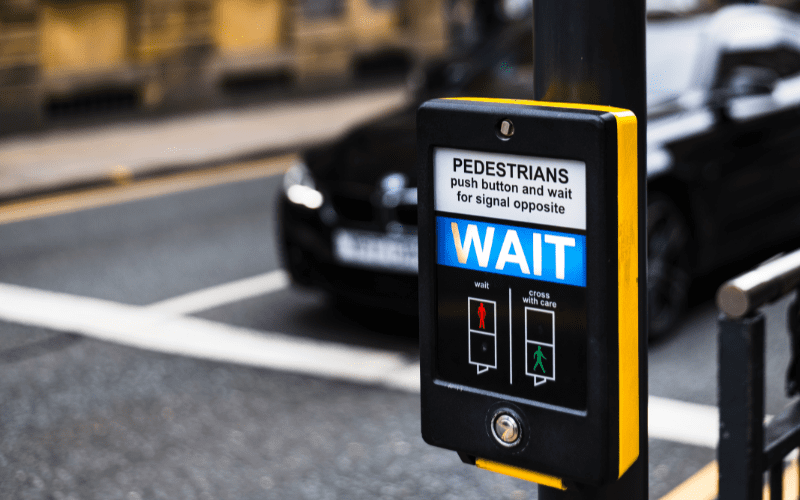Britain’s roads are woven with an array of pedestrian crossings, each designed to keep both foot traffic and vehicles moving safely and efficiently. Whether you’re a lifelong UK resident or a recent visitor, navigating these crossings can sometimes be confusing, thanks to their various rules, signals, and unique features. This guide explains the main types of pedestrian crossings in the UK, how they work, who can use them, and the situations in which each should be used.
Why Are There Different Types of Pedestrian Crossings?
Pedestrian crossings exist to allow people to cross roads safely in busy areas, and their variety is tailored to different kinds of traffic, road widths, and user needs. Some crossings provide priority to pedestrians at all times; others require collaboration and patience between foot and vehicle traffic. Each type of crossing is marked clearly by specific road signs and markings, and many have official names with a certain whimsical British flair, such as ‘zebra’, ‘pelican’, and ‘toucan’ crossings.
The Main Types of Pedestrian Crossings UK:
Zebra Crossings.
Zebra crossings are perhaps the most recognisable of all, marked by black and white stripes painted across the road, reminiscent of a zebra’s pattern. You’ll also spot flashing amber Belisha beacons on poles at each side of the crossing.
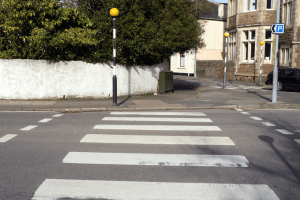
Who can use them? Zebra crossings are for all pedestrians, including those using wheelchairs, pushchairs, and mobility scooters. Cyclists are also permitted to cross, but they must dismount first.
When to use? Pedestrians can use zebra crossings at any time. Vehicles must give way to anyone stepping onto the crossing or waiting to cross, making this a safe and reliable choice at all hours.
Key features: There are no traffic lights. Motorists are legally required to stop when someone is on the crossing or waiting, but caution is always advised to make sure drivers have seen you.
Puffin Crossings.
Puffin crossings (Pedestrian User-Friendly Intelligent crossings) have traffic lights with sensors that detect when people are on the crossing. The tell-tale signs are pedestrian signals placed above the waiting button box, rather than across the street as with older pelican crossings. Pedestrians press the button when they want to cross, and the lights halt the traffic whilst they cross.
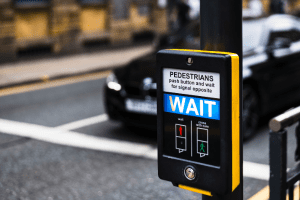
Who can use them? Anyone on foot, including those with visual impairments (who may use the tactile rotating cone beneath the button), as well as people pushing prams or using mobility aids.
When to use? Pedestrians press the button and wait for the green man to appear. The sensors mean the crossing time can adjust to ensure everyone has crossed safely before the lights change back to green for vehicles. Cyclists must dismount to cross.
Key features: Intelligent sensors keep traffic stopped as long as someone is on the crossing. Audible beeps and tactile feedback help those with visual impairments.
Pelican Crossings.
Did you know ‘Pelican’ stands for PEdestrian LIght CONtrolled? These crossings are being phased out in favour of puffin crossings, but many still exist. The main difference is that the pedestrian signals (the red and green man) are positioned across the street, rather than alongside you.
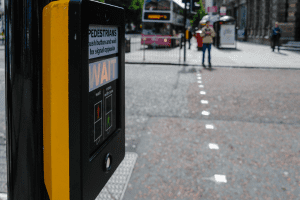
Who can use them? All pedestrians. Cyclists should dismount before crossing. Features such as audible signals and tactile cones assist those with disabilities.
When to use? Press the button, wait for the green man to show across the road, and then cross. The lights will flash amber for vehicles after the crossing phase, indicating they may go if the crossing is clear.
Key features: They are button-operated, and audible and tactile aids are common, but the crossing time is fixed.
Toucan Crossings.
If you’re preparing to pass your driving test, Toucan crossings are easy to remember. Toucan crossings are designed for ‘two can’ cross — meaning both pedestrians and cyclists may use them, side by side, without cyclists needing to dismount. These crossings are wider than usual and are commonly found near parks, cycle paths, and schools.

Who can use them? Pedestrians and cyclists, including those with pushchairs or mobility aids.
When to use? Operated by a button, with pedestrian and cycle signals placed together. Wait for the green cycle and green man to appear, then cross together.
Key features: No need for cyclists to dismount and they are often used where cycle routes meet main roads.
Pelican vs Puffin vs Toucan: What’s the Difference?
They are all types of traffic light-controlled pedestrian crossings. However, the main differences lie in who can use them (cyclists are included at toucan crossings), the position of the pedestrian signals, and whether smart sensors adjust the crossing time (only puffin crossings do this).
Pegasus Crossings.
One of the more uncommon types of pedestrian crossings in the UK is the Pegasus crossing. Named after the mythological winged horse, Pegasus crossings are designed for equestrians — horse riders, as well as pedestrians. You’ll find them near bridleways, riding schools, or areas with significant horse traffic.

Who can use them? Horse riders, pedestrians, and sometimes cyclists (if indicated). The crossing features two sets of controls — one at a normal height, and another higher up for riders on horseback.
When to use? Wait for the green horse signal to appear. Traffic lights stop vehicles, giving riders and walkers a safe crossing period.
Key features: Extra-wide crossings, safety fences, and dual-height buttons for accessibility from horseback.
School Crossings (Lollipop Crossings).
These are not permanent road markings but rather temporary crossings managed by a school crossing patrol. The iconic ‘lollipop person’ uses a tall, circular sign to halt traffic whenever children and parents need to cross before and after school hours.
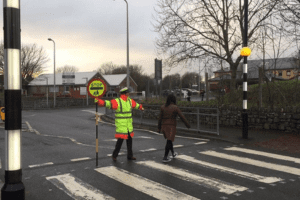
Who can use them? Primarily children, their parents, and carers, but anyone can cross when the patrol is present and has stopped traffic.
When to use? Only when the patrol steps into the road and displays the sign. All vehicles must stop, and pedestrians must follow the patrol’s guidance.
Key features: No permanent traffic lights or markings, but highly visible patrols and signs, usually in high-visibility clothing.
Uncontrolled Crossings and Courtesy Crossings.
Besides the formal, rule-bound crossings above, there are also ‘courtesy crossings’. These are often paved in a different material, raised, or marked by islands, but lack official signals or markings. While not enforced by the Highway Code, many drivers will stop to allow pedestrians to cross at these points.
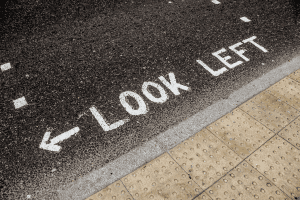
Who can use them? Anyone, but be aware that vehicles are not required to stop and may not always yield.
When to use? Use caution and make eye contact with drivers before stepping out.
Key features: Pedestrians have no legal priority, but common courtesy is expected.
Why You Should Never Wave People Across at Pelican Crossings?
Waving people across at a pelican crossing, or any pedestrian crossing, is a dangerous practice that should be avoided. While it may seem like a kind and helpful gesture, it can lead to serious accidents. Here’s why:
- You don’t know what’s coming. Your view of the road may be clear, but a driver in another lane, or an oncoming vehicle, may not have seen the pedestrian or your signal. Waving someone across gives them a false sense of security, and they may step into the road without checking properly, only to be hit by another vehicle.
- The pedestrian may not be ready. The person waiting to cross might not have seen you, or they may be distracted. They may also be waiting for another reason, such as a mobility issue, and your signal could rush them into a dangerous situation.
- It’s the pedestrian’s responsibility to cross safely. The Highway Code in the UK states that pedestrians should be left to decide for themselves when it is safe to cross. As a driver, your job is to be prepared to stop if they do decide to cross, but not to instruct them to do so.
- It goes against the Highway Code. Rule 195 of the Highway Code specifically advises against waving, flashing your lights, or using your horn to invite pedestrians to cross. This is because “it could be dangerous if another vehicle is approaching.”
Instead of waving, the correct procedure is to slow down, be prepared to stop, and if the pedestrian steps onto the crossing, you must give way. This ensures that the responsibility for crossing remains with the pedestrian and reduces the risk of an accident.
Pedestrian Crossing Safety Tips.
The UK’s crossings are increasingly designed with accessibility in mind. Tactile paving marks the edge of crossings for those with visual impairments. Audible signals and tactile cones help people who are deaf or blind. Cyclists and equestrians have special accommodations at certain crossings, ensuring all road users are considered.
Some general tips for safety:
- Always wait for the signal or green man before crossing (except at zebra and courtesy crossings).
- Do not cross diagonally; use the crossing as intended.
- Children should be accompanied by adults when using any crossing.
- Be aware of electric and hybrid cars, which may be quieter.
- Make eye contact with drivers when possible.
Related Articles:

New UK Driving Laws.
The DVLA update their driving laws each year, so it can be hard to keep on top of new driving laws across the UK and in your local area.

How To Claim For Pothole Damage.
Hitting a pothole, even at low speeds, can damage your car’s wheels, tyres, suspension, or steering alignment!
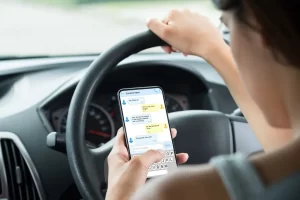
Worst Driving Habits.
Adopting bad driving habits can not only be dangerous, but they can also waste fuel and affect the performance of your vehicle.

